Dee Estuary Birding
Monthly Newsletter...
October 2023 Newsletter
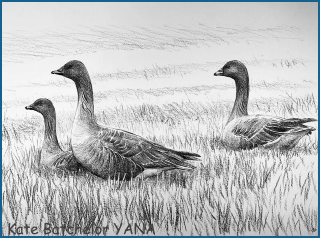
Pink-footed Geese

I got up shortly after first light on September 13th, by the time I got downstairs it must have been around 7.30am and I was somewhat surprised to see six texts and eight WhatsApp messages all of which had come in over the past 30 minutes. It was the first major influx of Pink-footed Geese of the autumn, and the number of texts and messages nicely demonstrates how much people love to see them!
There was nothing particularly remarkable about the
numbers that morning, the total moving was probably in the region of 2
- 3,000, but lovely to see. These days we are used to seeing large
flocks of Pink-footed Geese flying overhead and feeding on the marshes
and adjacent fields from September to April, but that certainly wasn't
always the case. So I thought it would be of interest to review the
status of Pink-footed Geese on the Dee Estuary including the recent
remarkable increase (and the even more recent and remarkable increase
on the Mersey Estuary!) and put it in a national context.
But first I refer you to 'Geese on the Dee Estuary - Part 1' (Ref 1) which was written just at the start of the Pink-footed Geese increase here and published in the Dee Estuary January 2012 Newsletter. It gives a nice summary of historical records going back over 100 years and more - so there is little point in me repeating the same in this article.
Pink-footed Geese (Anser brachyrhynchus) in the United Kingdom
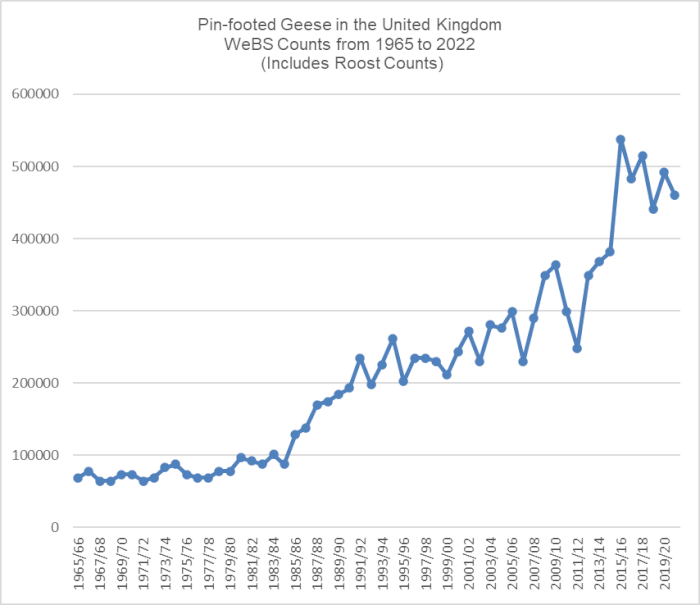
Regular counting of Pink-footed Geese started in the
1960s, in 1965/66 there was just under 70,000 in the country. After
breeding in Iceland and east Greenland the counts showed that they
first flew to Scotland, arriving in September and October. Many stayed
the winter there but the Ribble estuary and south Lancashire potato
fields
had also long been important for them and by the early 1970s counts of
at least 10,000 were typical there, peaking in mid-winter. 1975 saw the
establishment of Martin Mere (Wildfowl Trust) in south Lancs which gave
them a safe roost site and a large area to feed in free from shooting
(the Wildfowl Trust had bought the shooting rights in the surrounding
fields). Helped by safe roosting sites like Martin Mere numbers slowly
increased nationally so by 1983/84 the count went above 100,000 for the
first time. However, change was afoot when the geese discovered the
delights of sugar
beet in the coastal fields of North Norfolk. None were recorded here in
the winter of 1981/82 yet by 1989/90 there were 15,600 (numbers
continued to increase here with a phenomenal 122,000 counted in 2003).
No doubt helped by their new diet of sugar beet the period between 1984
and 1990 saw a big rise
nationally and they more than doubled to 200,000, a slower rate of
increase then followed but by 2008 they reached over 300,000 for the
first time.
With total numbers now around 300,000 many goose experts thought that counts would plateau out at that high level, but everyone was surprised when in 2015 there was an incredible 530,000 counted - more than double the 2011 total. It was during this period that we saw the start of a near exponential increase of Pink-footed Geese on the Dee Estuary, which nicely brings us to the next section.

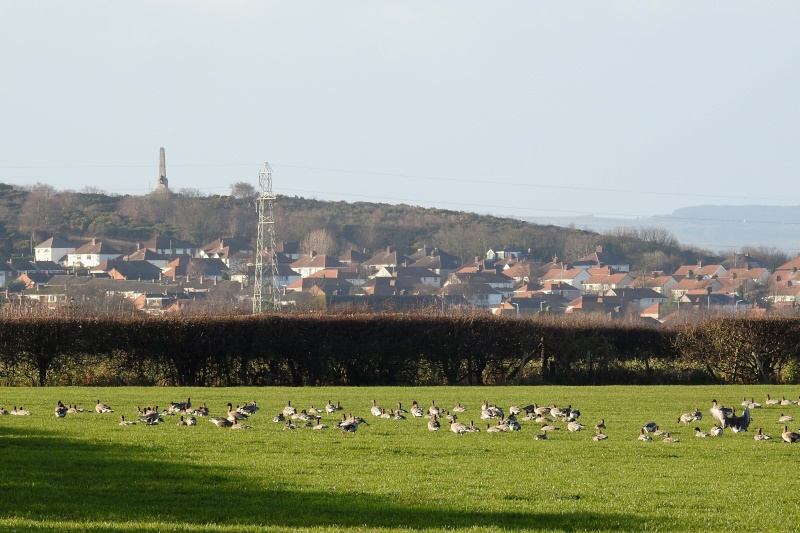
Pink-footed Geese on the Dee Estuary
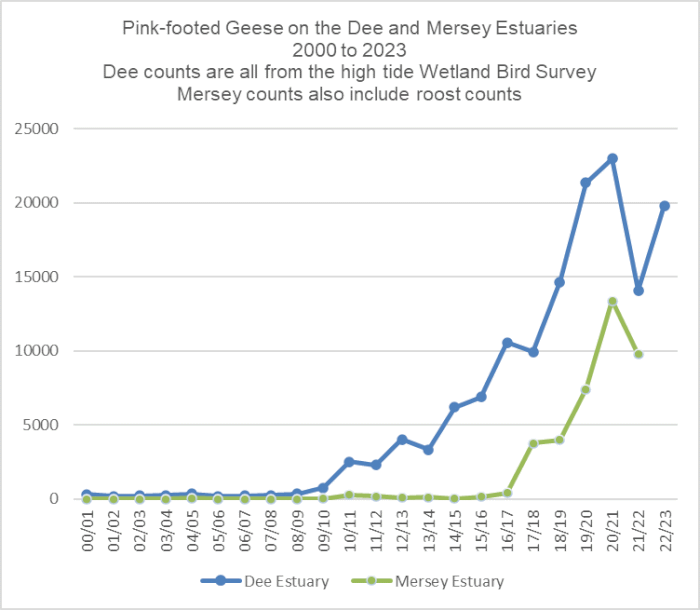
As you will see if you read Ref 1, Pink-footed Geese were present in the Dee Estuary before World War II but were driven away by the industralisation at the head of the head of the estuary and by over-shooting. Despite the huge rises in numbers nationally the geese stayed away from the estuary for over 70 years, with only the odd small flock seen (apart from 1979 when there was a significant cold weather movement which peaked at 1,500 in February that year). But the long absence has made their return all the more exciting and below I detail some of the highlights.
Looking back at the WeBS (Wetland Bird Survey) data
there were signs that the geese were returning at the beginning of the
century with an average maximum winter count of 194 from 2000 to 2009,
compared with the previous 20 years when the average count was just 27.
These were birds counted on the ground, but we sometimes saw much
larger
flocks passing overhead. Pink-footed Geese leave North Norfolk in
January and it was these birds we sometimes saw flying up the estuary
then heading for south Lancs. Probably the largest number of
Pink-footed Geese ever recorded on the Dee Estuary up to that point was
seen in 2007, and I quote from the February 2007 Dee Estuary Newsletter:
A spell of still sunny
weather from January 22nd to 24th (2007) was an opportunity for
Pink-footed Geese to move across the country from Norfolk to South
Lancs. Many passed overhead through the Dee Estuary with 850 on the
22nd, 350 on 23rd and a remarkable 4,500 - 5,000 on 24th. The first
flocks appeared around 11am each day, just enough time for the birds to
have left the Wash at first light and traveling at 30 - 40mph over a
distance of about 120 miles.
But it was during the two cold winters of 2010 when
Pink-footed Geese started to over-winter in significant numbers, this
was from the C&W 2010 Bird Report:
Numbers probably not seen
since the early 20th century overwintered during both winter periods on
the Dee marshes. The two highest counts in the early winter period were
700 at Parkgate Marsh on Jan 2nd and 670 at Burton Marsh on Jan 31st.
Large numbers were also recorded at IMF, either on the reserve or
flying over between Burton Marsh and Shotwick Fields, Flintshire, with
600 on Feb 19th and 750 on both Mar 1st and 3rd. In the late winter
period numbers had already reached 600 by Nov 18th at Parkgate Marsh,
followed by 700 on Dec 7th and 750 on Dec 19th. Numbers peaked on Dec
23rd and 24th with counts of 1000.
Later on in that winter (2010/11) those counts were
soon
bettered during the spring tides in February when 2,000 were flushed by
the sea from Parkgate Marsh - I well remember looking in amazement at
that huge number of birds, and the noise they made. The following
winter was similar and in February 2012 they took to feeding on the
marsh close to Parkgate Promenade giving wonderful views.

Numbers continued to increase with notable flocks including 4,500
off
Gayton in November 2013, and in March 2017 7,000 were seen in the air
together at Neston. Hundreds also started feeding in inland fields all
along the west coast of Wirral, around Shotwick Fields, Burton,
Parkgate, around Irby and Pensby, Thurstaston and between Greasby and
Hoylake. All this meant that skeins were constantly in the air over
much of west Wirral as the geese moved between the coast and inland
fields.
By the winter of 2017/18 several hundred took to roosting overnight on the edge of Heswall Marsh, at first light they moved inland flying over Thurstaston beach in several skeins. They still do this and it's a wonderful sight - on December 24th 2022 4,855 were counted coming over, fantastic! Other notable counts in recent yours were at least 10,000 at Burton Mere Wetlands during a big spring tide in March 2020, and 12,500 were seen flying into roost on the edge of the marsh at Neston and Parkgate on October 25th 2021.
Over the past few winters Pink-footed Geese have
also started feeding on coastal fields the Welsh side of the estuary,
anywhere between Connah's Quay and Point of Ayr. More unexpected was
the sight of hundreds in fields around Whitford, two or three miles
inland from Mostyn Docks, on September 21st 2023.

Arriving and Departing
The first ones back from Iceland are usually
recorded during the first two weeks of September, and it's quite likely
that some may well make it here without stopping, a journey of around
950 miles. The first flock in 2021 arrived very early, on September
1st, but it's usually a week or two later - this year, 2023, the first
small skein was spotted on the 7th. By mid-September we can start
getting quite large numbers arriving, although the flocks tend to be
scattered so difficult to count, and by early October thousands will be
here; for example 5,000 were counted from Denhall Quay on October 8th
2020.
You would have thought January was too early for the geese to be thinking of heading back north, but that is what the Pink-footed geese in North Norfolk do with just a few stragglers left by early February. I've already described a big movement of Norfolk birds flying through the estuary in January 2007, but since the big rise in numbers here it's difficult to tell local from cross-country movements. However, recently we've seen three big flocks heading north in late January and early February and these are likely to be birds moving from Norfolk - 4,220 which roosted on Heswall shore overnight then flew north on February 3rd 2021, 5,000 flew north over Thurstaston and West Kirby at first light on January 28th 2022 and 6,330 north over Heswall shore on 22nd January 2023.
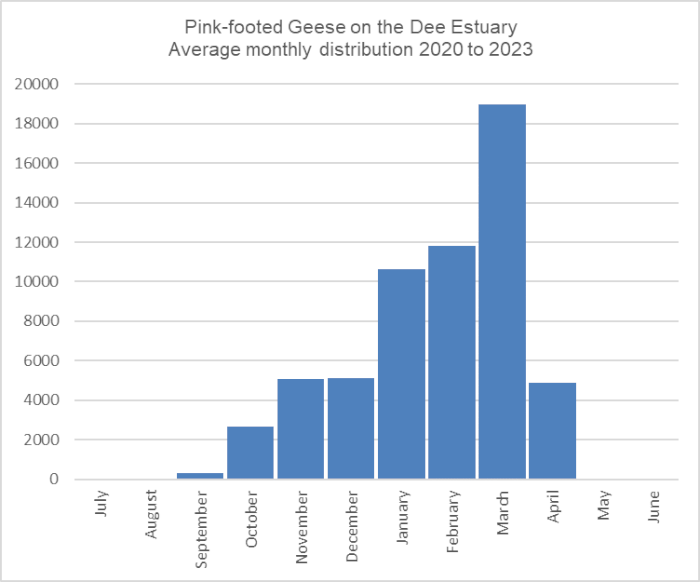
In contrast to Norfolk the Pink-footed Geese on the
Dee Estuary actually increase in numbers in January and February, and
peak in March, as the bar chart shows. My guess is that the surge in
numbers in January is driven by geese which have left Norfolk some of
which then stay on the Dee Estuary for the rest of the winter. As
winter progresses, the geese spend more time grazing the saltmarsh off
Parkgate and in late winter, with the cessation in shooting, they move
onto Burton Marsh. On 16th February 2021 a remarkable 18,000 were
grazing on the saltmarshes at Burton and Parkgate/Gayton.
April is when the Pink-footed Geese leave us, and it
is often spectacular. Each year is different but the normal pattern is
for large skeins to head out of the estuary at first light anytime
between late March until the third week of April. 8,000 flying past
Hilbre during the first two hours of daylight on April 17th this year
(2023) was exceptional, and a wonderful sight. Some years their exodus
is prolonged over several weeks such as in 2021 when the first flock
heading north was on March 30th and the last on April 28th, and the
total counted leaving over that period was 16,173. Often we don't see
them as they fly out at night and on April 13th 2021 a large flock was
heard flying over Hoylake around midnight, taking seven minutes to pass
over.
One exodus that sticks in my memory was on April 9th
2016 during a big spring tide, having been flushed from the marsh by
the inrushing sea the geese decided it was time to leave, and I quote
from my Newsletter for that month:
the most interesting
event as far as I was concerned was seeing the over-wintering flock of
Pink-footed Geese, probably around 4,000 strong at that time, leaving
the Dee marshes on the 9th at the start of their migration back to
Iceland. They left in many flocks, some several hundred strong, from
dawn to high tide, i.e. from 7.30am to 1pm. Many passed over my house
in Caldy and were seen from Hilbre and all along North Wirral. I was at
Heswall when a total of at least a thousand took off from the marshes
as the tide came in and headed north. It was certainly a mass exodus,
just awesome.
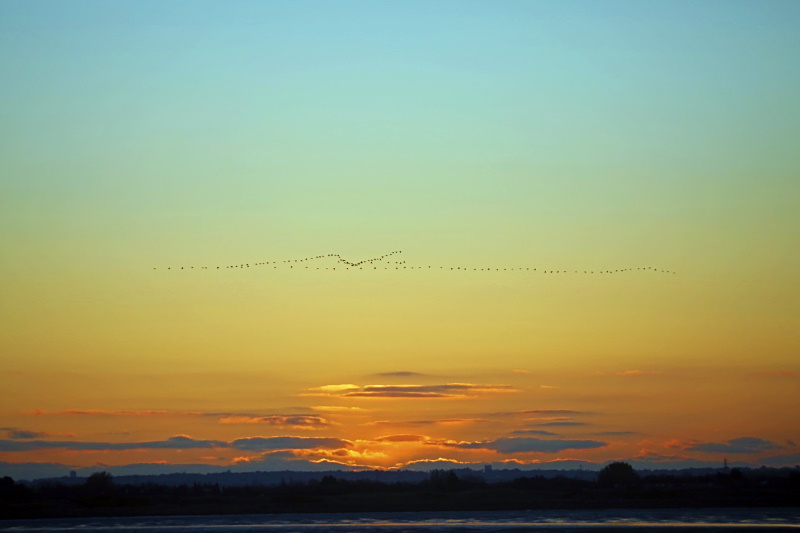
Pink-footed Geese on the Mersey Estuary
The recent rise in numbers of Pink-footed Geese on
the Mersey has been just as dramatic as on the Dee, although the
increase started several years later, in 2017/18 (see graph above). So
far the peak
count is 13,400 in January 2021, and it's interesting that the peak
count is in January rather than March, as it is on the Dee, so it seems
highly likely that it's the same birds which are moving around the area
- as Pink-footed Geese do, of course.
Hardy (Ref 5), writing just at the start of WWII, says "small flights still visit the Mersey marshes, Ince and Stanlow" but, again like the Dee, they were then largely absent for many years and a look at the WeBS counts from 1965 reveals mainly counts of zeros right up until the 1990s, an exception being a nice count of 850 at Ince during hard weather in January 1982 which also produced plenty of other records across Cheshire that month.
Further up the Mersey Valley, at Woolston Eyes, they saw exceptional numbers of Pink-footed Geese in 2022 and I quote from their Annual Report (Ref 6):
October brought further,
but unexceptional, movements, until the final week when numbers rose to
levels never seen before at Woolston. On 25th October 1200 flew
east over No.4 bed, followed by 2000 in the same direction the next day
and 3600 also flying east in many skeins on the early morning of the
27th. The movement was reported to be over by 09.00 hours. This
was just the beginning of the huge numbers reported in the following
two weeks. Up to 4000 flew east at 08.20 on 30th October, but at
least 10,000 flew west over Latchford Locks in 20 minutes in the late
afternoon of 31st October, presumably going to roost on the Mersey.
These massive skeins continued to be reported daily in the first two
weeks of November, with birds flying east in the early mornings and
west in the evenings. The last breath-taking numbers were 8000 at
dawn on 10th November, 10,000 east on 12th November and a minimum of
10,000 flying west on 13th November. The observer of that count
considered that as many as 12,000 birds could have been involved.
By then these large noisy skeins had attracted the attention of the
general public, while workers from a factory adjacent to Woolston
waited to see the geese pass over each evening, and the local
Warrington Guardian newspaper published many positive comments of
people who had watched this great wildlife spectacle.
A Final Note
For further
reading I would recommend Colin Well's (retired RSPB Dee Estuary
Manager) Pink-footed Geese account in The Birds of Wales (Ref 7). Colin
quite rightly points out that the spectacular growth in numbers on the
Dee Estuary during the second decade of the 21st century has been
greatly aided by the by the creation of the large sanctuary area by the
RSPB.
References
1. Richard Smith, Geese on the Dee Estuary - Part 1, Dee Estuary Birding January 2012 Newsletter.
2. Austin, G.E., Calbrade, N.A.,
Birtles, G.A., Peck, K., Shaw, J.M. Wotton, S.R.,
Balmer, D.E. and Frost, T.M. 2023.
Waterbirds in the UK 2021/22: The Wetland Bird Survey and Goose
& Swan Monitoring Programme. BTO/RSPB/JNCC/NatureScot.
3. Neil Friswell and Colin Wells, Dee Estuary and
North Wirral Foreshore Annual Report, 2022/2023 (and various previous
reports).
4. Cheshire and Wirral Bird Reports 1964 to 2021.
5. Eric Hardy, The Birds of the Liverpool Area,
T.Buncle & CO,
Ltd, 1941.
6. David Bowman, Woolston Eyes Conservation Group, Annual Report 2022.
7. Rhion Pritchard et al., The Birds of Wales, Liverpool University Press, 2021.
8. Latest Sightings and Newsletter archives - http://www.deeestuary.co.uk/.9. Nick Acheson, The Meaning of Geese, Chelsea Green, 2023.
Richard Smith
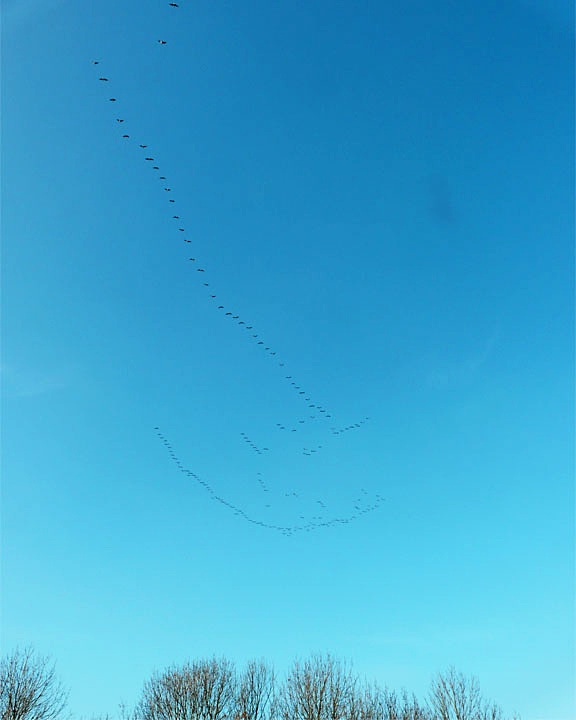
Colour Ring Report
Shelducks
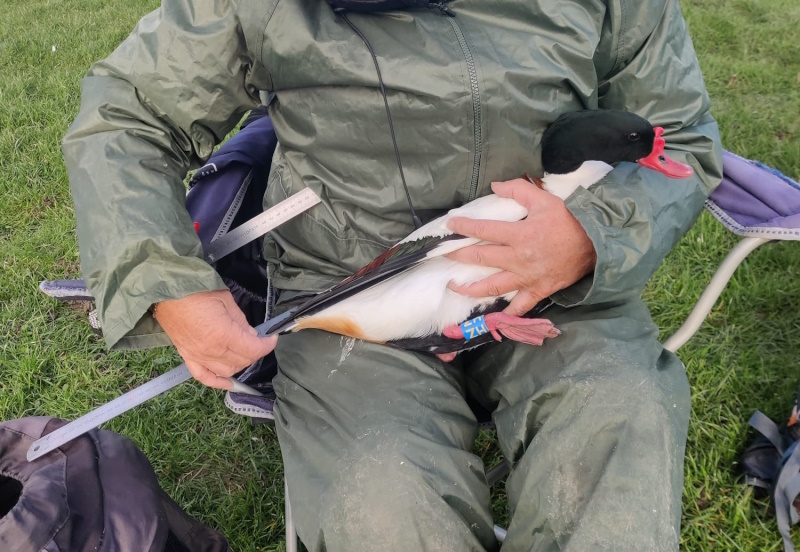

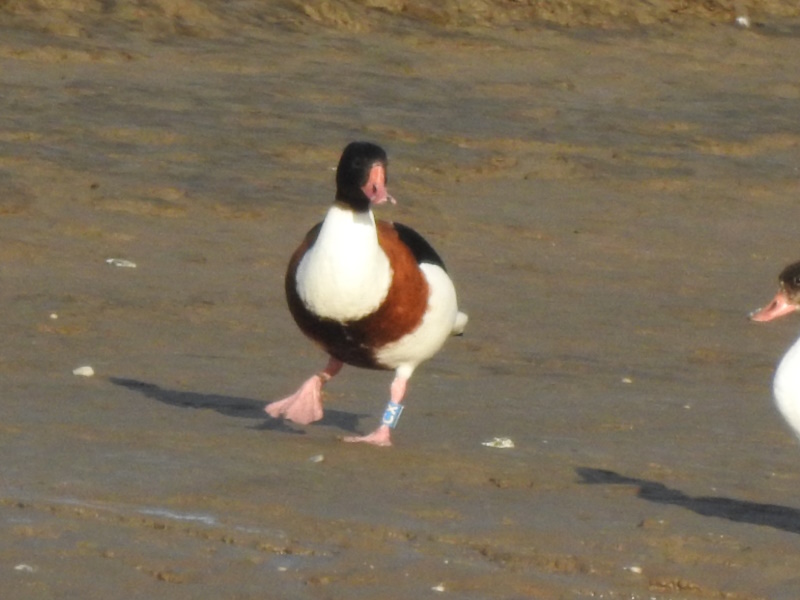
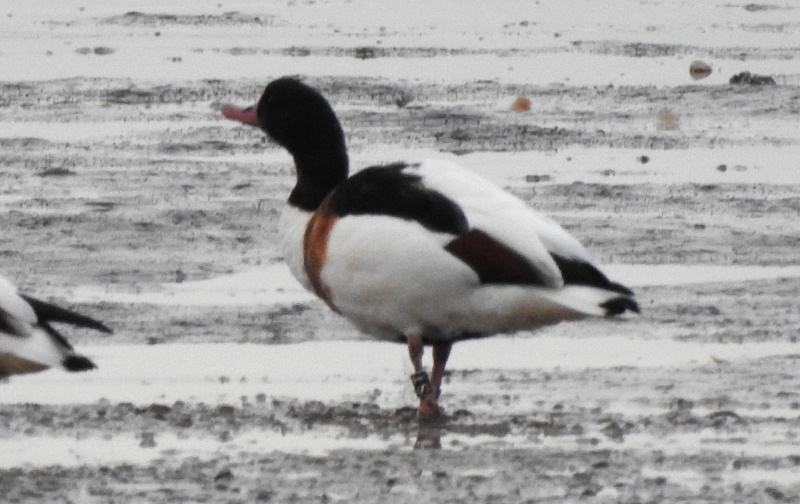
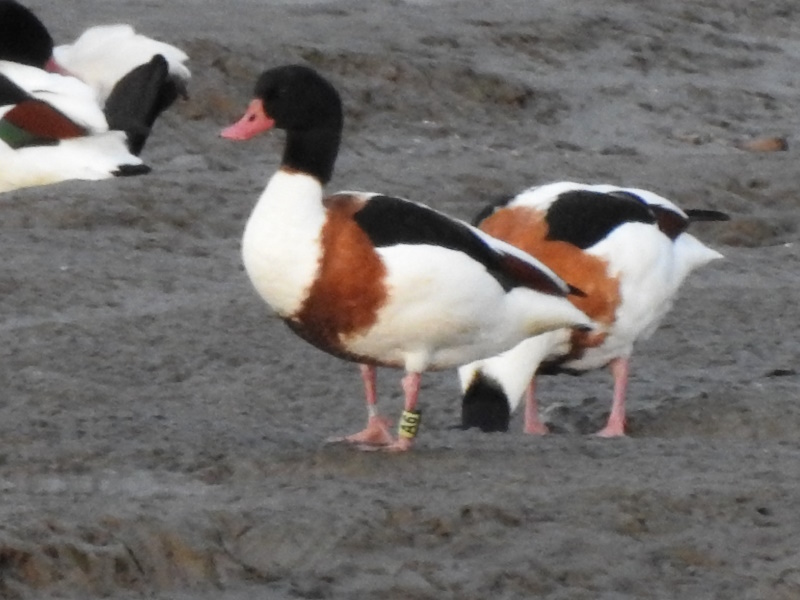
During August and September we had 43 records of 25
different
colour-ringed Shelducks, making a significant contribution to the
current research into Shelduck migration and their movements (see https://shelducks.co.uk/).
These Shelducks were ringed at various locations
including Martin Mere and Longton Marsh (both in Lancs), Withymoor Pool
in Shropshire and Lower Derwent Valley NNR in Yorkshire.
One of the most interesting movements are the Shelducks which have been ringed at the Lower Derwent Valley NNR. Since 2019 we have recorded 17 birds ringed from there, and many have returned over several years - so it's a definite movement west and not just random dispersion. Many are ringed in Yorkshire in spring but some also in the winter, so it's not only breeding birds which have been ringed. One, Black ST, was ringed as a duckling at North Duffield Carrs (Lower Derwent) on June 16th 2007. It was seen this September at Thurstaston and is now 16 years old. It was also seen here last year, which was a nice surprise for the ringers as it was the first record of Black ST since 2007.
At the end of September we received feedback for
Lime A6 recorded at Thurstaston on 18/09/2023. Turns out it's even
older than Black ST as it was ringed as an adult at Martin Mere on
12/12/2007, which means it's now at least 17 years old.
Cormorants
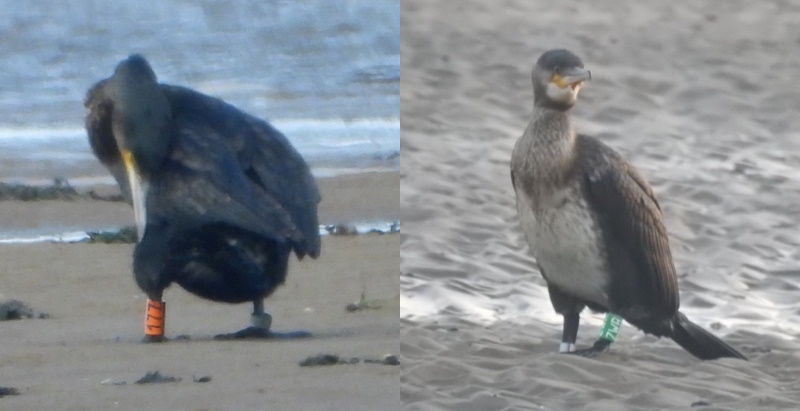
Over 1,000 Cormorants are sometimes present in the Dee Estuary and off north Wirral but usually distant, and they can be quite wary so not ideal for colour ring reading. Even so we've done quite well recently and we read six rings in August and these two, above, in September.
O-177 and G-ZWR were both ringed as chicks this year
with the former at Hale Duck Decoy in May and the latter at Puffin
Island in June. O-177 was at Hoylake on 30/08/2023 and G-ZWR off Hilbre
on 26/08/2023 and 03/09/2023, both first sightings since they were
ringed.
Ringed Plovers

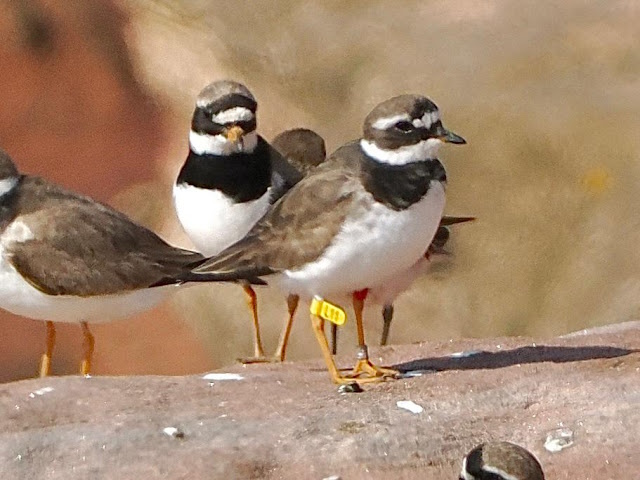
R - Yflag(VLS)
Ringed on the island of Giske on the west coast of Norway on 02/09/2017.
Recorded at Hoylake on 30/08/2023.
R - Yflag(L11)
Ringed on the island of Giske on the west coast of Norway on 26/08/2022.
Recorded at Hilbre on 02/09/2023.
These are the sixth and seventh colour-ringed Ringed
Plovers in our database. They come from a good variety of locations
including Iceland, Norway (three), Dundee and Germany (two).
Oystercatchers
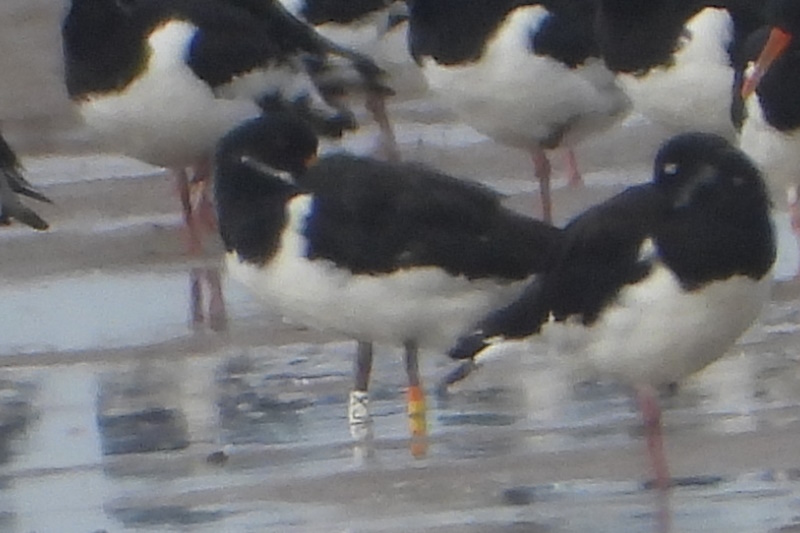

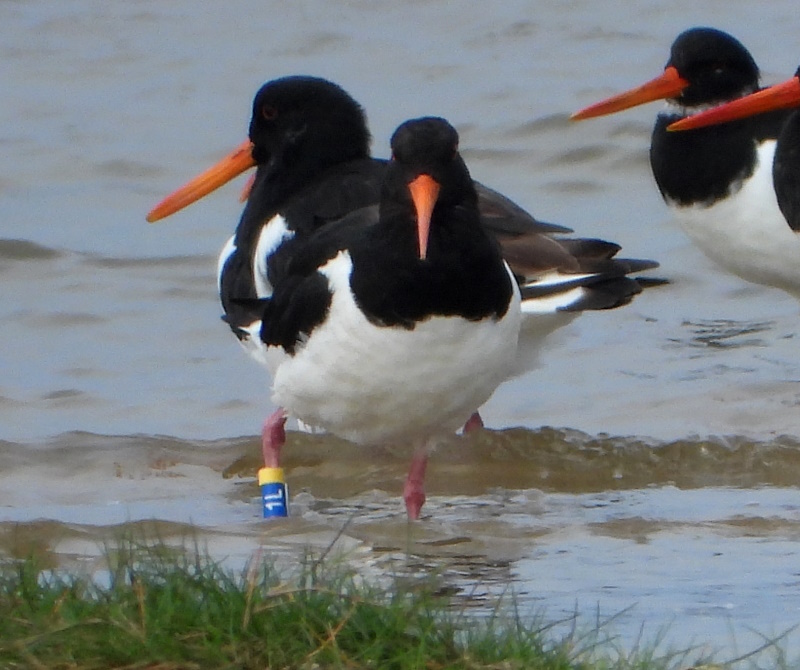
Hoylake shore is a great place to see Oystercatchers, particularly on a
rising tide as they walk up from Meols in their thousands - "The March
of the Oystercatchers". You would think it was
an ideal time to see colour rings on their legs but you wouldn't
believe the number of legs I've scanned through over the years without
success. Anyway, I got lucky over the past few weeks and recorded the
above three - it wouldn't be such fun if it was easy!
OY-W(XJ) and NG-G(YY) were both ringed as chicks in Iceland as part of the ongoing study there of their migration strategies, so it's good to provide the ringers with some useful data. OY-W(XJ) was ringed in June 2022 right up in the furthest north-west of the country. It was last seen at the same site up until August 2022, before I saw it at Hoylake on 15/09/2023. NG-G(YY) was ringed in June 2016 in southern Iceland. It was first seen at Hoylake in March 2018 then again on 31/08/2023. The only other record was at Seaforth in April 2022.
Y-B(1L) was
ringed at Dawlish Warren, Devon, in February 2018. It was recorded
there, or the adjacent Exe Estuary, from late summer to late winter
every winter until February 2020.
Recorded at Hoylake on 31/08/2023.
This is the fourth Oystercatcher ringed at Dawlish
Warren we've recorded here. Presumably they breed further north and
pass through here on their way back to spend the winter in Devon.

Black-headed Gull
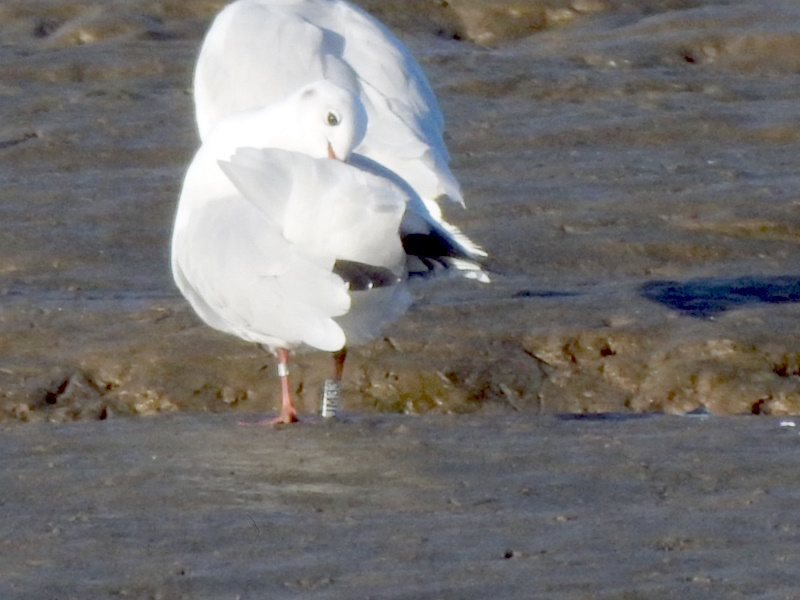
White Ring (JM33)
Ringed in Oslo, Norway, on 15/06/2019, as a chick.
Recorded back at Oslo from April to July 2022.
It was on Thurstaston Shore on 03/09/2023
Sandwich Terns
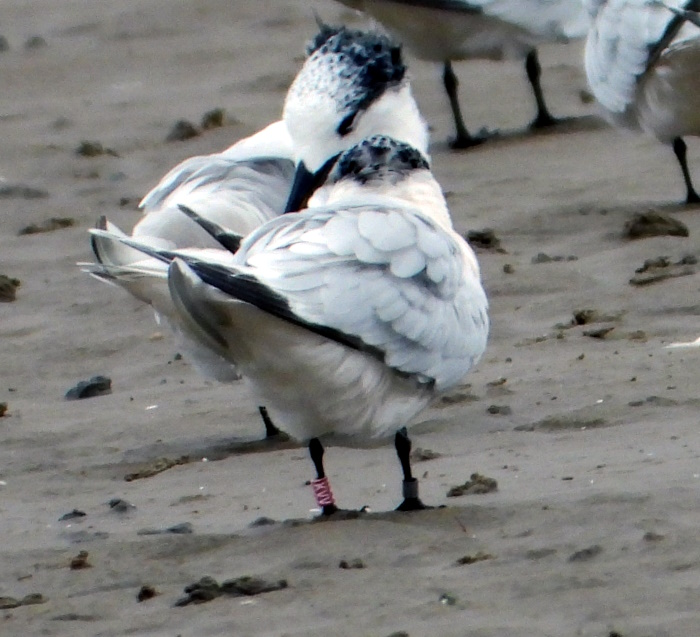
I was going to write an article
about the Sandwich Terns we saw this summer, but after hearing about
the devastation that HPAI (bird flu) caused at Cemlyn Bay, and other
colonies, I decided it was inappropriate and insensitive to be boasting
about the number
of colour rings we saw.
Colour Rings were recorded by Richard Smith, Stephen
Hinde, Alan Hitchmough, Steve Williams, Sean O'Hara and Charles
Farnell.
Richard Smith
September Bird News

If only. If only the strong south westerlies on the
18th and 19th had swung round to the north-west, if only the wind that
blew strongly on the afternoon of the 22nd had lasted into the next
day, if only the gales that blew on the 27th were from the north-west
rather than the south. But we shouldn't complain as we did actually get
some Leach's Petrels coming past and most people who were able to get
down to north Wirral on the 22nd saw at least one. So the total was two
on the 18th and at least 10 on the 22nd (although one or two may well
have been seen more than once as they flew west). But, 'if only' the
weather had been a bit different then I can't help thinking we would
have had a lot more. We also saw a few skuas through the
month including six Arctic from Hilbre on the 10th with four more from
Meols on the 22nd, and an adult Pomarine Skua from Wallasey on the
23rd.
Like August there were a few Black Terns about, including five from Hilbre on the 16th, but undoubtedly the most unexpected tern record was the 190 Arctic Terns counted from Hoylake during the strong south-westerly winds on the 18th, this is the largest number recorded over the past 30 years or more. Most years they barely make it into double figures along our coast. Much larger numbers, usually a few thousand in total, are seen migrating north in the Morecambe Bay area in spring, but in autumn numbers at Morecambe Bay are similar to those we see here - usually in the region of 10 to 20 at most. So an interesting count!

Curlew Sandpipers are another species we always
associate with September and there was a good passage, in fact the
fourth
highest this century boosted by the fact that there were six
consecutive days when
13 were at Burton Mere Wetlands. I'll be writing a more comprehensive
summary of this passage, and how it compares to previous years, in my
next newsletter. Little Stints were also about with one at Burton Mere
Wetlands most of the month, plus one or two more seen at several sites
around the estuary and north Wirral.
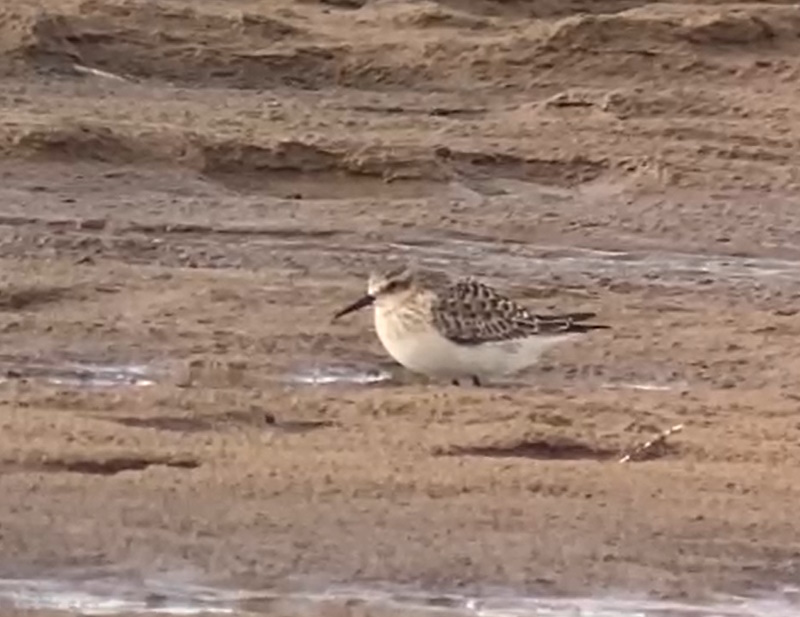
But the bird of the month was, of course, a Baird's
Sandpiper, spotted by Sean O'Hara at Hoylake on the 20th and still
giving decent views the following day. This is the first record for
Wirral, and the three previous records for Cheshire have all been on
the Weaver Bend, the last one in September 1985. On the Dee Estuary
itself there have been two records - at the Point of Ayr in 1971 and at
Connah's Quay in 1975. They breed in the far north of Alaska and
Canada, and also the far east
corner of Siberia, they winter on the west coast of
south America. Nearly all the ones we see in this country are
juveniles, including this one at Hoylake (around seven are recorded
each year in the UK).
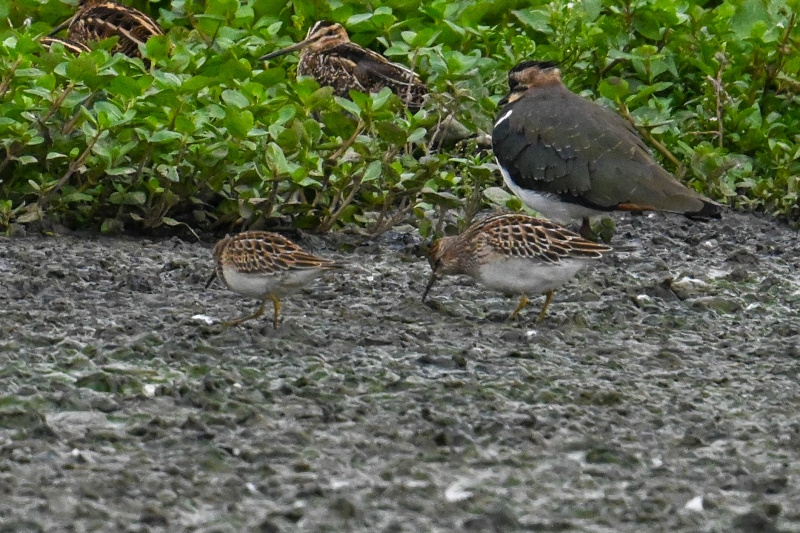
A more regular rarity is the Pectoral Sandpiper and
one or two were at Burton Mere Wetlands on several days in the second
half of the month, with three on the 29th.
Good to see were up to 13 Spoonbills at Parkgate,
and more unexpected were 15 Cattle Egrets at Burton Mere Wetlands, 13
of these were photographed together in the company of some Snowdonian
ponies!
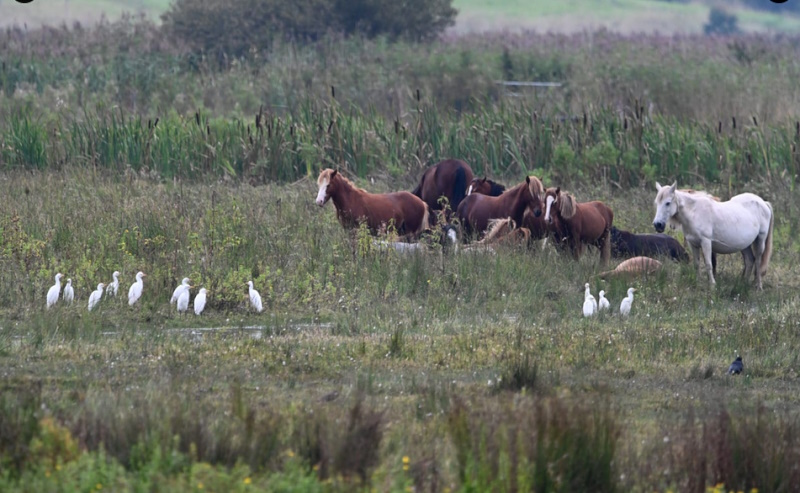
© John Hewiitt
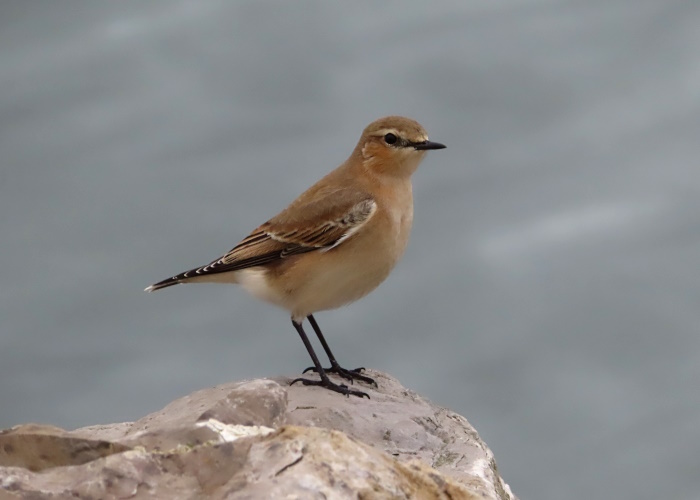
September 13th © Colin Flynn
What to expect in October
We often get gales in October and, particularly early in the month, that should bring in plenty of sea birds including Leach's Petrels and skuas, and maybe Sabine's Gulls and Grey Phalaropes if we're lucky.
Out on the estuary there will be thousands of Shelducks with the Dee the most important site in the country for them at this time of year. Stand on top of the cliff at Thurstaston and you will see Dawpool Bank covered in them.
As described above there will be a lot of
Pink-footed Geese but Brent Geese will also be arriving, these are best
seen around Hilbre and West Kirby Shore and may reach 200 or more by
the
month-end.
The Marsh Harrier roost will be in double
figures, it can either be at Parkgate or Neston, or both. Get there
late afternoon and you may see ten or more in the air together. Hen
Harriers and Short-eared Owls should also be on view.
October is the month we usually see Yellow-browed
Warblers, numbers can vary greatly and often just one or two are
recorded, but in 2016 they seemed to be everywhere! http://www.deeestuary.co.uk/news1216.htm.
East winds can bring in plenty of passerines
to our coast on migration - early morning is best and on a good day of
'Vis Mig' hundreds, perhaps thousands, of Redwings, Fieldfares,
Starlings and finches will be flying along the coast in flock after
flock. October 2022 was spectacular for Redwings. Other passerines
which often turn up are the first Snow Buntings of the winter, and a
Black Redstart or two.
Forthcoming Events
October Highest Spring Tides (Liverpool)
Also see Tides page.
1st October, 13.08hrs (BST), 9.8m.
2nd October, 13.45hrs (BST), 9.6m.
29th October, 11.03hrs (GMT), 9.7m.
30th October, 11.42hrs (GMT), 9.7m.
Forthcoming Events
Also see events at https://events.rspb.org.uk/deeestuary